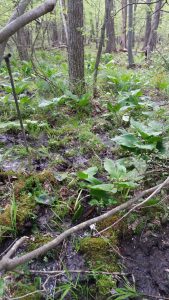Whether you’re walking along a path or driving down the road, you may notice areas where the trees and plants are unlike the vegetation growing in most of the surrounding areas. When you look more closely, you will likely realize that these areas are located next to surface water features such as rivers, streams
A wetland is a transitional area between an aquatic habitat and the surrounding land. Wetlands provide protection against flooding and erosion by slowing the flow of storm water and reducing sediment loading. Wetlands have a positive impact on freshwater quality by filtering flow and by absorbing and breaking down pollutants. In addition, wetlands provide an important ecological habitat and food source for many species, and serve as recreational areas enjoyed by local residents and visitors.
The Freshwater Wetlands Act was enacted by New York State in 1975, with the intent to “preserve, protect and conserve freshwater wetlands and their benefits, consistent with the general welfare and beneficial economic, social and agricultural development of the state”. To gain the protection under the Act, a wetland must be at least 12.4 acres in size (save in the Adirondack Park where the threshold is lower), unless considered to be of “unusual local importance” as described in Article 24 of the Environmental Conservation Law. Also protected is the “adjacent area” within 100 feet of the outer boundary of the wetland. The Freshwater Wetlands Act ranks wetlands into classes, depending on NYSDEC’s ranking of benefits associated with each; the higher classes are afforded more protection. The United States Army Corps of Engineers (US ACOE) also regulates activities to protect wetlands of any size under Section 404 of the Clean Water Act.
Activities that could negatively impact wetlands are regulated by these Acts. A freshwater wetlands permit is required to perform certain regulated activities both in the wetland itself and on adjacent areas. Such activities include excavation, grading, new construction, and modification or expansion of existing structures, to name a few. In order to obtain a permit to conduct a regulated activity, the benefits of the action must counteract the loss of ecological services provided by the wetland. However, a permit may be granted if actions are taken to compensate for the impacts to the wetland, such as creating a new wetland or restoring the wetland after activities cease. Performing work without the appropriate permit can lead to civil or criminal court actions, fines, and a mandate to remove structures and materials from the affected wetland area and perform remedial actions.
If you are planning a construction project, contact Walden Environmental Engineering. Our wetlands experts can help identify and delineate wetlands in your area, assist in the permitting process, and develop alternatives to ensure that these wetlands are protected during the project. Feel free to call Walden with any questions related to freshwater wetlands or other environmental concerns. or check out our website for our full list of environmental consulting services.
